China roadmaps ambitious space projects, starting with 11 launches in next two years
Space station building focus on next two years’ schedule
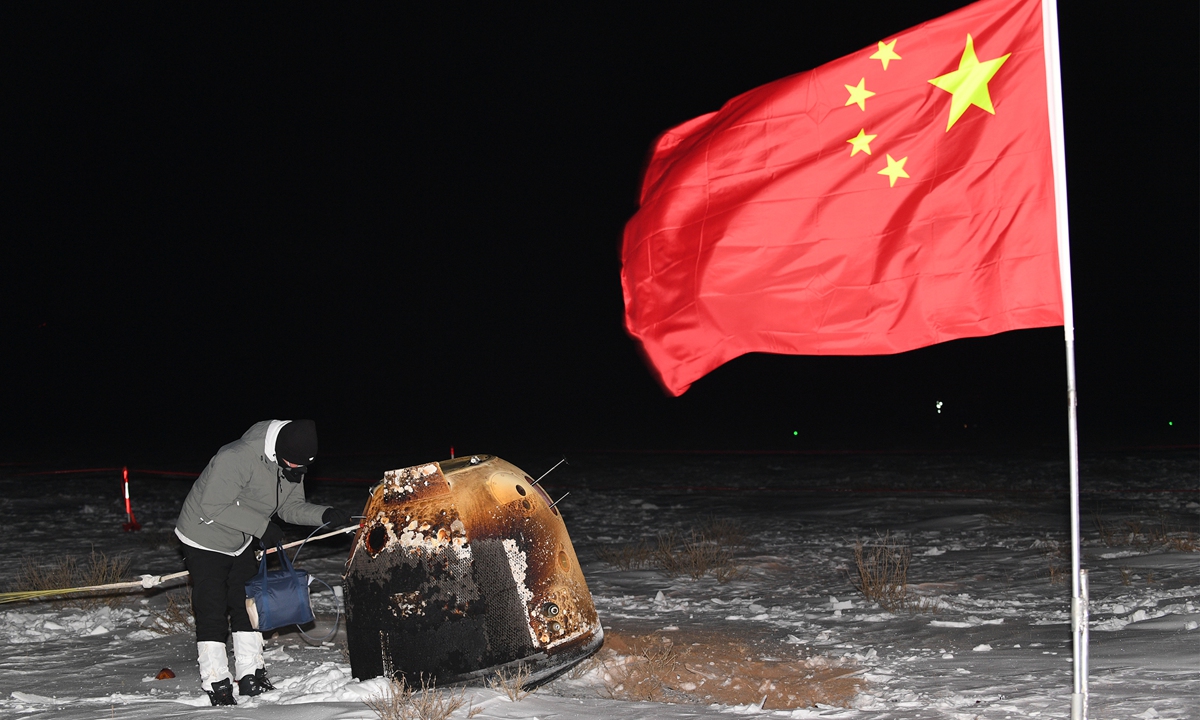
China's Chang'e-5 successfully landed at its designated landing area in Siwangzi Banner, N China's Inner Mongolia Autonomous Region around 2 am Thursday, carrying around 2 kgs of lunar samples. Photos show workers checking craft's status. Photo: Our Space/ Wang Jiangbo
Closely following the complete success of Chang'e-5 lunar sample return mission on Thursday, China's National Space Administration (CNSA) disclosed plans for a slew of ambitious space projects that include a new three-step plan for the country's future moon and deeper space exploration missions, which Wu Yanhua, the CNSA deputy head, referred to as "surveying, constructing, and exploiting," as opposed to the already conquered goals of "orbiting, landing and returning."
Wu made the remarks during a special press conference at the State Council Information Office in Beijing on Thursday afternoon, and in the early morning, the re-entry capsule of the Chang'e-5 probe executed a safe landing in its predetermined site in Siziwang Banner of North China's Inner Mongolia Autonomous Region, drawing a perfect conclusion for not only the 23-day single mission but also China's increasingly complex "orbiting, landing and returning" moon exploration scheme that was blueprinted in 2004.
"Surveying" means to explore the space and geological environment of the moon and other cosmic bodies, and the variety of radiation in space, Wu said.
"Constructing" is to master the capability of building infrastructure, remarked the CNSA official, citing Queqiao the relay satellite of the Chang'e-4 probe that is capable of providing constant moon-Earth tracking and communication service function, for example, and he also mentioned the prospects of building the capability of long-term water and electricity supply.
"Exploiting" refers to human development of extraterrestrial resources, which Wu sees as the common goal of interstellar probe missions from all over the world.
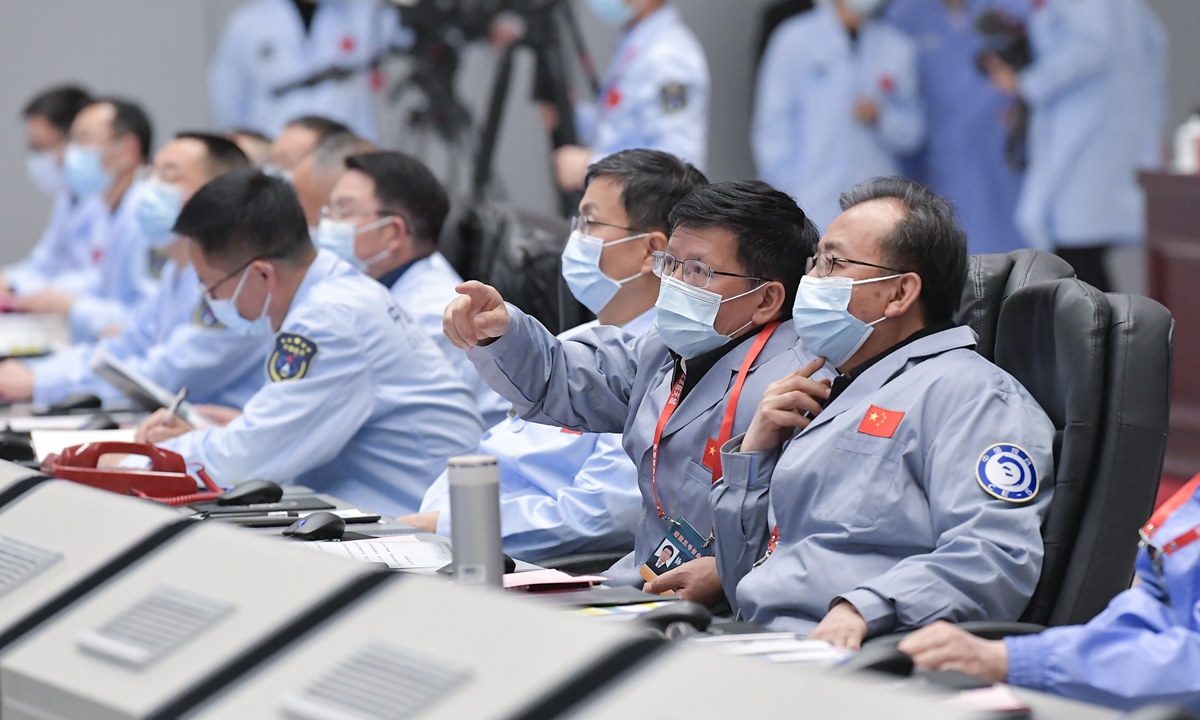
Technical personnel work at the Beijing Aerospace Control Center in Beijing on December 1. China's Chang'e-5 spacecraft successfully landed on the near side of the moon late Tuesday and sent back images. Photo: CNSA
Walk the walk in space
China's space industry does not only talk the talk, but is walking the walk.
The past decades witnessed the steady and robust development of China's space exploration programs, which have acted as proof of self-reliance, resilience and the CNSA's capacity for organizing major programs in a concerted, systematic fashion, space insiders told the Global Times on Friday.
And they now have all the reason in the world to believe that China will practice its space plans for years to come, well-paced and always headed for the infinity of the universe.
Global Times has learned from the CNSA that Phase 4 of the country's moon exploration is already underway, which will include four missions named after the moon goddess in Chinese mythology, Chang'e.
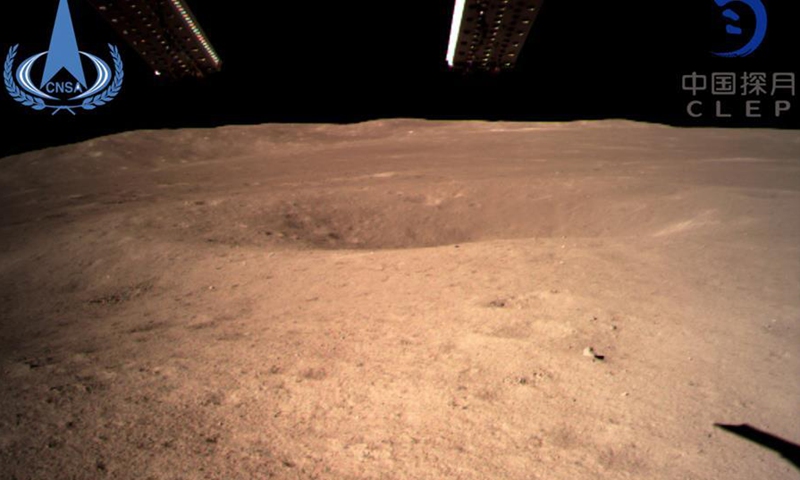
Photo provided by the China National Space Administration on Jan. 3, 2019 shows the first image of the moon's far side taken by China's Chang'e-4 probe.File photo:Xinhua
The Chang'e-4 probe that achieved the man's first robotic landing on the dark side of the moon in January 2019 was the first step in the new phase.
And the agency and scientists are mulling over the details of the Chang'e-6 mission, which could be enforced during the 14th Five-Year Plan (2021-25) period.
The Chang'e-6 mission, also a lunar material retrieving task just as Chang'e-5, would inherit and further extend the technology breakthroughs and complexity of the previous mission. The sample collecting location could be the moon's south pole or even the dark side of the moon, which has never been done before by any nation.
"But if the Queqiao satellite still functions well by the time we launch Chang'e-6, we may also consider sending it to the far side to take some samples there," Wu Yanhua told reporters.
"This is because there has never been a mission to return samples from the far side, and if we do so ... that will be very meaningful to scientists around the world," Wu noted.
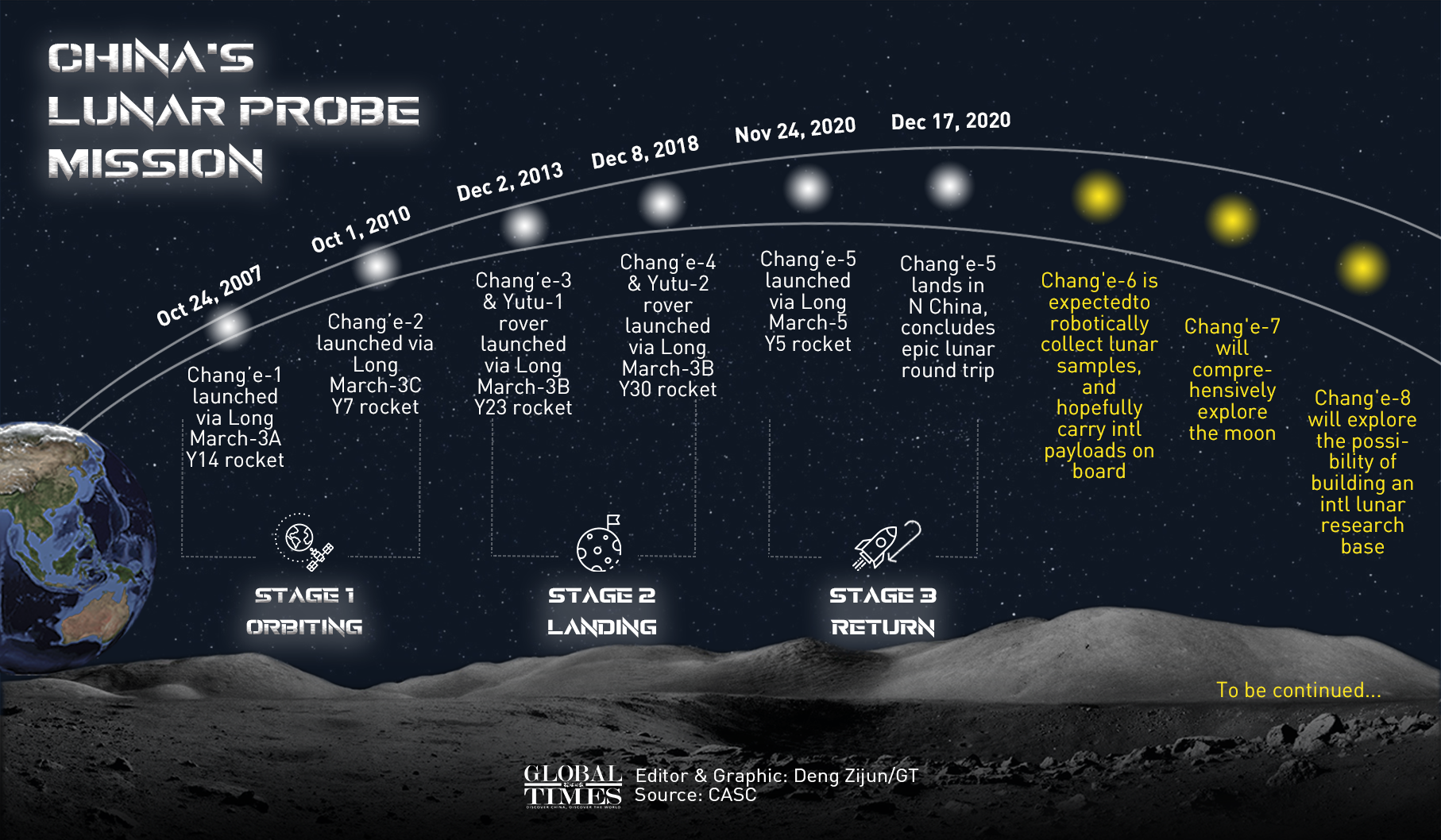
Infographic: Deng Zijun/GT
The country's space agency is also planning Chang'e-7 and -8 missions and taking those missions as opportunities; China will reach out to relevant countries and international agencies to jointly study the capability of building a moon research base and verify core technologies.
Xu Hongliang, the CNSA spokesperson, revealed on Thursday that Chang'e-7 is likely to explore the moon's south pole, which is similar to Russia's LUNA-26 probe mission. "Under the cooperation mechanism of two governments, China and Russia are preparing to push forward relevant collaboration."
Xu added that "We also welcome other countries around the world that are carrying out international moon base construction programs to join us, and make contributions to the cause of enhancing human well-being with space solutions."
China launched the country's first-ever Mars probe, codenamed Tianwen-1, on July 23 from Wenchang Space Launch Center in South China's Hainan Province, kickstarting its inter-planetary exploration.
Currently, Tianwen-1 has traveled 370 million kilometers and reached more than 100 million kilometers from Earth, as per the CNSA latest update on the mission earlier this week.
The spacecraft is expected to arrive in the gravity of the Red Planet by mid-February next year and then start orbiting Mars. And it aims to land on the planet by mid-May 2021, where it will release a rover to conduct a survey mission.
There would be three more planetary probe missions - an asteroid probe and sampling mission, a Mars sample mission, and a mission to orbit Jupiter - according the CNSA.
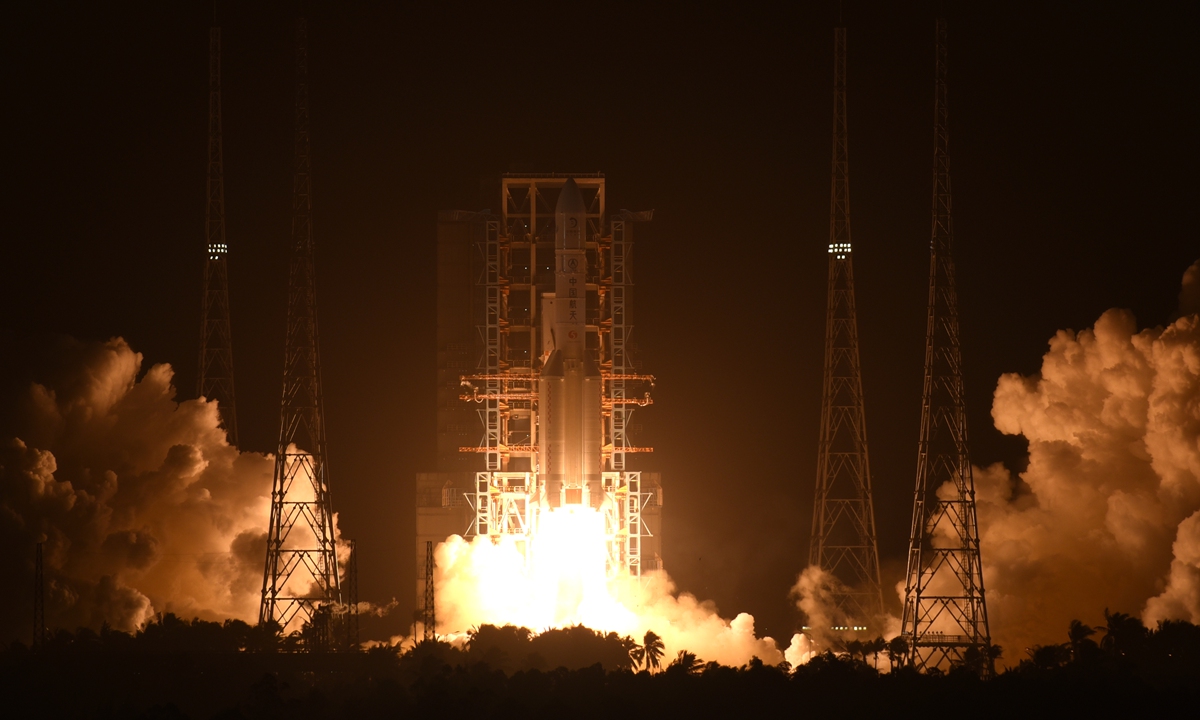
China launches Chang’e-5 mission via Long March-5 rocket to retrieve Moon rocks at Wenchang Space Launch Center from South China’s Hainan Province early Tuesday morning. Photo: Li Dike
Busy schedule for crewed missions
China will carry out 11 launches that include four crewed spaceships and four cargo spaceship flights in the next two years, as it aims to complete the building of the country's first space station by around 2022.
The space station, named Tiangong, meaning heavenly palace, will be a T shape with a core module at the center and a lab capsule on each side. It will be able to accommodate three astronauts under normal circumstances and up to six during a crew replacement.
The Chinese space station will operate in low-Earth orbit at an altitude from 340 kilometers to 450 kilometers for more than 10 years, supporting large-scale scientific, technological and application experiments.
Commenting on the prospect of sending Chinese astronauts to the moon, Wu Yanhua, the CNSA deputy head, said Thursday that the space station construction would be a priority for the next two years, and the topic of crewed lunar missions still awaits further discussion.
He also stressed that if there are any Chinese crewed moon mission, they shall be different from those by the US and Soviet Union during the space race period, which focused merely on who got there first and who made more landings.
We shall focus on the scientific research value [in future crewed moon missions], and breakthroughs made during the Chang'e-5 mission - take-off from the moon, rendezvous and docking on the lunar orbit, and re-entry to Earth - are all solid foundations laid for future crewed missions, he said.
China is also pressing ahead with the research and development of a crewed heavy-lift carrier rocket, whose launch capability would reach 70 tons to the low Earth orbit (LEO) and 27 tons to the lunar transfer orbit (LTO), according to a tentative roadmap for the country's future moon landing strategy unveiled by Zhou Yanfei, deputy chief designer of China's crewed space program in September, Global Times previously reported.
None of the existing members of China's Long March carrier rocket family could allow the country to achieve such an ambitious crewed moon landing, Zhou said during his keynote speech at the China Space Conference, adding that the development of a new heavy-lift crewed carrier rocket is among the challenges in reaching the goal.
CNSA officials on Thursday also mentioned such new-generation heavy-lift launch vehicles, calling them a must in the country's space industry development.
"We are working on key technological solutions and optimizing plans, and we will report to the country for approval when the conditions are ripe," Wu revealed.
Newspaper headline: China roadmaps ambitious space projects